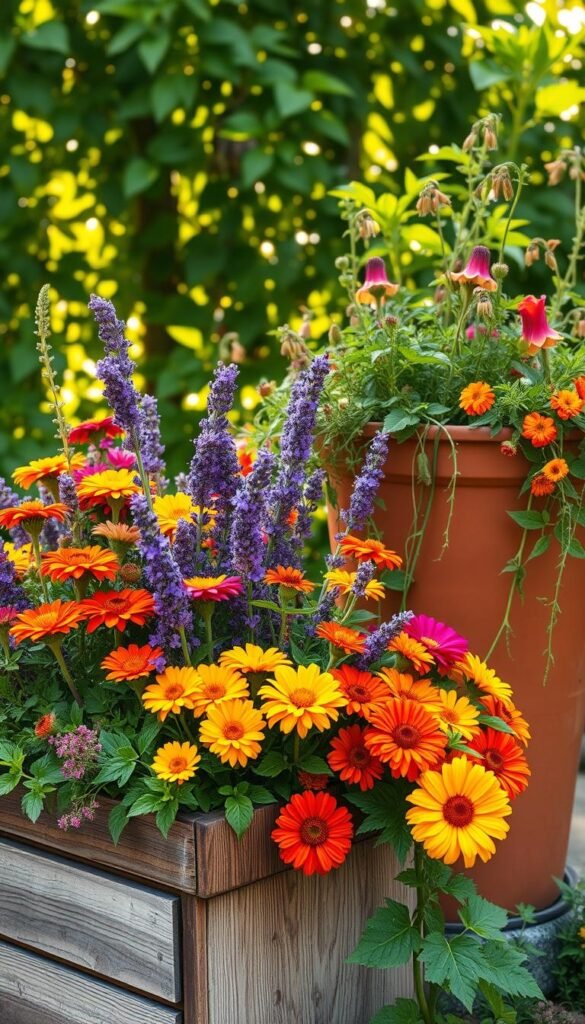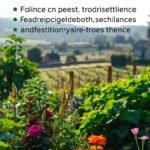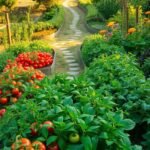Want to turn your balcony or patio into a buzzing oasis? Even with limited room, you can create a thriving space that supports bees, butterflies, and hummingbirds. The secret? Designing a vibrant setup that balances beauty and purpose.
Using pots and planters lets you grow nectar-rich varieties without needing a traditional garden bed. Choose sturdy vessels with drainage holes and fill them with quality soil to keep roots healthy. Pair sun-loving zinnias with trailing petunias, or mix herbs like lavender with edible blooms—your options are endless!
Bright colors and fragrant petals act like a welcome sign for winged visitors. Bees adore purple coneflowers, while monarchs flock to milkweed. For nonstop action, layer plants that bloom at different times. A well-placed water source or shallow dish of pebbles adds extra support for tiny guests.
Ready for inspiration? Explore vibrant plant combinations that thrive in confined spaces. We’ll walk you through soil tips, seasonal care, and creative layouts to make every inch count!
Getting Started with Your Pollinator Container Garden
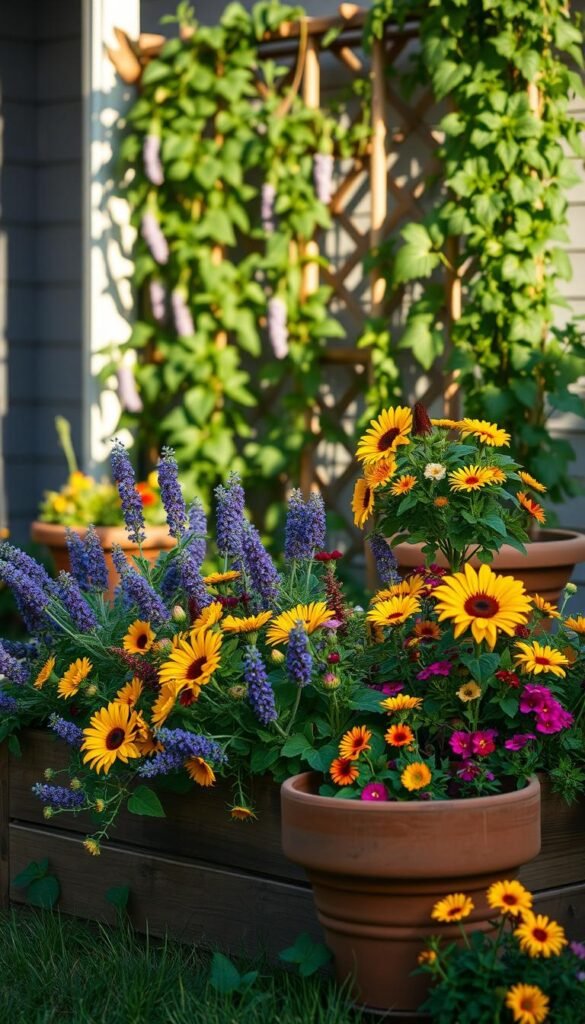
Even a tiny balcony can become a lifeline for bees and butterflies. Success begins with thoughtful preparation—your choices in pots, soil, and placement set the stage for a flourishing habitat.
Selecting the Ideal Containers and Soil
Start with pots that match your plant’s growth habits. Shallow-rooted herbs thrive in 8-inch-deep vessels, while sunflowers need at least 12 inches. Always prioritize drainage holes to prevent soggy roots. Pair your containers with a lightweight potting mix enriched with compost—this combo retains moisture without waterlogging.
Understanding Your Garden’s Space and Sunlight Needs
Track how sunlight moves across your area for 2-3 days. Most nectar-rich varieties crave 6+ hours of direct sun daily. If your spot gets partial shade, opt for bee balm or columbine. Measure your available room to avoid overcrowding—leave space for air circulation and future growth.
Water needs shift with the seasons. In spring, check soil moisture daily as temperatures rise. During frost warnings, move delicate pots indoors or wrap them in burlap. Match your seed choices to your climate—heat-loving zinnias won’t survive an early freeze!
Designing a Stunning Pollinator-Friendly Container Garden
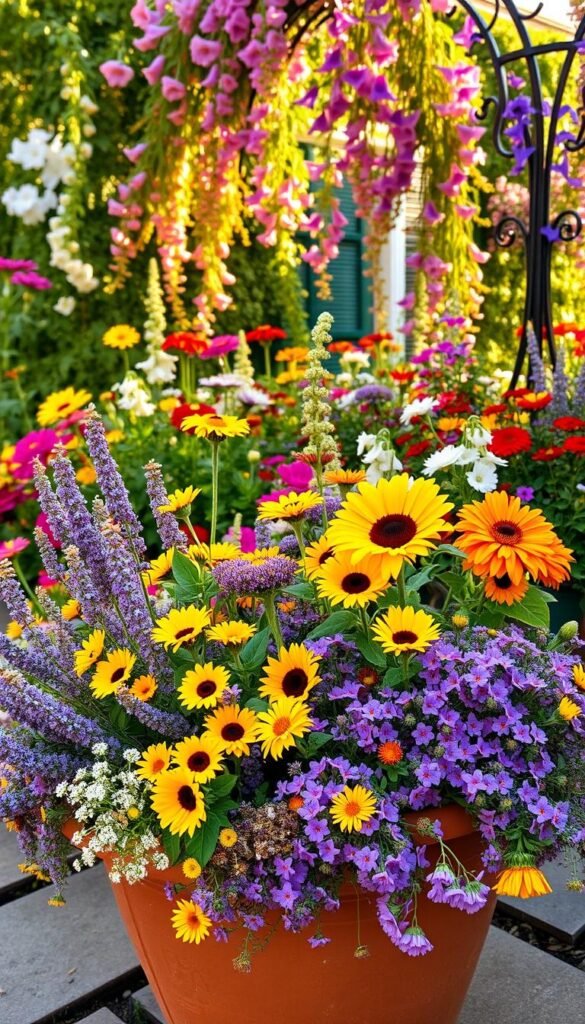
Transform your space into a lively hub for nature’s helpers with smart container design. A balanced mix of heights, textures, and colors creates visual drama while serving pollinators’ needs. Start by choosing plants with varying growth habits to maximize your pot’s potential.
Master the Thriller-Filler-Spiller Formula
This classic approach builds dimension in your pollinator container. Begin with a bold centerpiece like upright agastache or salvia—these “thrillers” grab attention. Surround them with medium-height fillers such as marigolds or coreopsis. Finish with trailing plants like sweet potato vine, which spill over edges for softness.
| Component | Purpose | Examples |
|---|---|---|
| Thriller | Vertical focus | Agastache, salvia |
| Filler | Bulk & color | Marigolds, zinnias |
| Spiller | Soft edges | Sweet potato vine, lobelia |
Create Depth with Color and Height
Pair purple salvias with yellow lantana for striking contrast. Tall verbena behind low-growing alyssa adds depth. Remember: pollinators spot bright hues best. Include white blooms for night-flying moths. Rotate seasonal variety to maintain year-round interest.
Experiment with unexpected garden ideas—try stacking pots or mixing herbs with blooms. Your creative design becomes both art and ecosystem support!
Container Gardening Flowers That Attract Pollinators
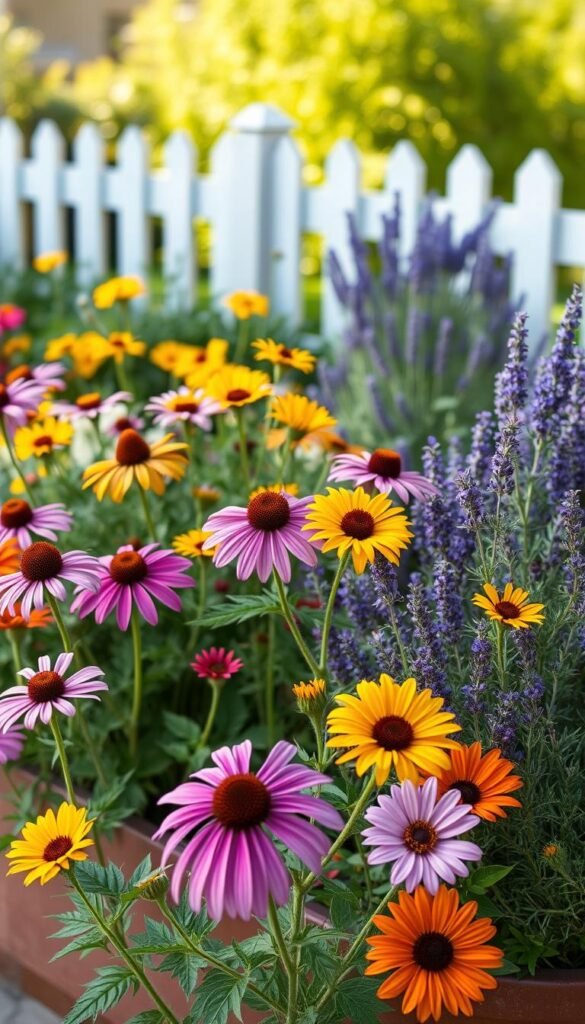
Your potted paradise can become a vital pitstop for nature’s hardest workers. By selecting specific varieties and arranging them thoughtfully, you’ll create a buzzing sanctuary that nourishes pollinators while adding vibrant charm to your space.
Favorite Pollinator Plants: Bees, Butterflies, and Hummingbirds
Top performers combine long bloom times with rich nectar stores. Teenie Genie® Lantana dazzles with sunset-colored clusters that butterflies love, while Evolution™ Colorific™ Coneflower offers multi-hued petals packed with pollen. Balmy™ Lilac Bee Balm releases a minty fragrance that lures bees butterflies can’t resist.
| Plant | Key Feature | Best For |
|---|---|---|
| Teenie Genie® Lantana | Drought-tolerant blooms | Butterflies & hummingbirds |
| Colorific™ Coneflower | Multi-season color | Bees & beneficial insects |
| Balmy™ Bee Balm | Fragrant foliage | Bees butterflies |
Planting Strategies to Maximize Nectar and Pollen
Cluster purple flowers like salvia with white flowers such as alyssum for high contrast that attracts diverse species. Leave 6-8 inches between plants in your pollinator container garden to prevent overcrowding. Companion planting boosts productivity—try pairing basil with zinnias to deter pests naturally.
Deadhead spent blooms weekly to encourage new growth. Include shallow dishes of water with stones for drinking spots. For more ideas on maximizing small spaces, explore companion planting techniques that support both edibles and ornamentals.
Creative Container Garden Ideas and Maintenance Tips

Keep your vibrant oasis thriving all season with clever design choices and simple care routines. Strategic planning ensures nonstop color while supporting winged visitors through every growth phase.
Seasonal Planting and Blooming Considerations
Rotate plants to match nature’s calendar. Start with cool-weather pansies in spring, then transition to heat-loving lantana for summer. As late summer arrives, add asters and goldenrod to sustain insects preparing for migration. This staggered approach keeps your pots lively for 6+ months.
Watering, Fertilizing, and Deadheading for Continuous Blooms
Check soil moisture daily during summer heat—water when the top inch feels dry. Use a balanced liquid fertilizer every 2 weeks to fuel blooms. Snip spent flowers weekly with clean shears. This redirects energy into new growth instead of seed production.
- Morning watering reduces evaporation
- Slow-release granules nourish plants for 3 months
- Trim yellow foliage to prevent disease spread
Incorporating Unique Plant Combos for Added Interest
Pair spiky red celosia with mounding blue lobelia for bold contrast. Mix fragrant lemon thyme with trailing million bells—their foliage textures delight humans while serving as a source for butterflies hummingbirds. For shady spots, combine coral bells and begonias.
| Sun Combo | Shade Combo | Dual-Purpose |
|---|---|---|
| Zinnias + Basil | Fuchsia + Coleus | Nasturtium + Dill |
| Attracts bees | Lures moths | Feeds pollinators & you |
Track insects visiting your creations—their presence confirms your garden’s health. For more patio setup ideas, explore space-saving layouts that merge beauty with functionality.
Final Thoughts on Your Container Garden Journey
Your journey to create a thriving habitat starts with a single pot. Whether on a sunny patio or balcony, these spaces can burst with life when you choose plants pollinators adore. By matching your selections to local zones and sunlight patterns, you’ll craft a resilient ecosystem that supports hummingbirds and bees alike.
Late spring is your golden window to establish vibrant flower displays. Pair quick-growing annuals with perennials suited to your region. Remember: strategic watering and seasonal rotations keep blooms coming. For effortless beauty, explore low-maintenance raised bed options that thrive in confined spaces.
Don’t hesitate to experiment—swap plants yearly or test bold color pairings. Those fluttering wings visiting your creations prove your impact. Every bloom you nurture becomes a lifeline for nature’s helpers while brightening your daily view.
Now’s the time to dig in. With thoughtful planning and care, your compact garden will ripple with life, season after season. Happy growing!
